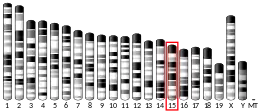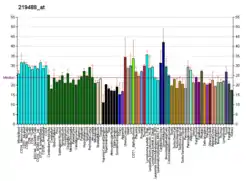A4GALT
Lactosylceramide 4-alpha-galactosyltransferase is an enzyme that in humans is encoded by the A4GALT gene.[5][6]
The protein encoded by this gene catalyzes the transfer of galactose to lactosylceramide to form globotriaosylceramide, which has been identified as the P(k) antigen of the P blood group system. The encoded protein, which is a type II membrane protein found in the Golgi, is also required for the synthesis of the bacterial verotoxins receptor.[6]
References
- GRCh38: Ensembl release 89: ENSG00000128274 - Ensembl, May 2017
- GRCm38: Ensembl release 89: ENSMUSG00000047878 - Ensembl, May 2017
- "Human PubMed Reference:". National Center for Biotechnology Information, U.S. National Library of Medicine.
- "Mouse PubMed Reference:". National Center for Biotechnology Information, U.S. National Library of Medicine.
- Keusch JJ, Manzella SM, Nyame KA, Cummings RD, Baenziger JU (Sep 2000). "Cloning of Gb3 synthase, the key enzyme in globo-series glycosphingolipid synthesis, predicts a family of alpha 1, 4-glycosyltransferases conserved in plants, insects, and mammals". J Biol Chem. 275 (33): 25315–21. doi:10.1074/jbc.M002630200. PMID 10854428.
- "Entrez Gene: A4GALT alpha 1,4-galactosyltransferase (globotriaosylceramide synthase)".
Further reading
- Dunham I, Shimizu N, Roe BA, et al. (1999). "The DNA sequence of human chromosome 22". Nature. 402 (6761): 489–95. Bibcode:1999Natur.402..489D. doi:10.1038/990031. PMID 10591208.
- Steffensen R, Carlier K, Wiels J, et al. (2000). "Cloning and expression of the histo-blood group Pk UDP-galactose: Ga1beta-4G1cbeta1-cer alpha1, 4-galactosyltransferase. Molecular genetic basis of the p phenotype". J. Biol. Chem. 275 (22): 16723–9. doi:10.1074/jbc.M000728200. PMID 10747952.
- Kojima Y, Fukumoto S, Furukawa K, et al. (2000). "Molecular cloning of globotriaosylceramide/CD77 synthase, a glycosyltransferase that initiates the synthesis of globo series glycosphingolipids". J. Biol. Chem. 275 (20): 15152–6. doi:10.1074/jbc.M909620199. PMID 10748143.
- Furukawa K, Iwamura K, Uchikawa M, et al. (2001). "Molecular basis for the p phenotype. Identification of distinct and multiple mutations in the alpha 1,4-galactosyltransferase gene in Swedish and Japanese individuals". J. Biol. Chem. 275 (48): 37752–6. doi:10.1074/jbc.C000625200. PMID 10993874.
- Furukawa K, Yokoyama K, Sato T, et al. (2002). "Expression of the Gb3/CD77 synthase gene in megakaryoblastic leukemia cells: implication in the sensitivity to verotoxins". J. Biol. Chem. 277 (13): 11247–54. doi:10.1074/jbc.M109519200. PMID 11782470.
- Koda Y, Soejima M, Sato H, et al. (2002). "Three-base deletion and one-base insertion of the alpha(1,4)galactosyltransferase gene responsible for the P phenotype". Transfusion. 42 (1): 48–51. doi:10.1046/j.1537-2995.2002.00014.x. PMID 11896312.
- Mammalian Gene Collection Program Team; Strausberg, R. L.; Feingold, E. A.; Grouse, L. H.; et al. (2002). "Generation and initial analysis of more than 15,000 full-length human and mouse cDNA sequences". Proceedings of the National Academy of Sciences. 99 (26): 16899–16903. Bibcode:2002PNAS...9916899M. doi:10.1073/pnas.242603899. PMC 139241. PMID 12477932.
- Iwamura K, Furukawa K, Uchikawa M, et al. (2004). "The blood group P1 synthase gene is identical to the Gb3/CD77 synthase gene. A clue to the solution of the P1/P2/p puzzle". J. Biol. Chem. 278 (45): 44429–38. doi:10.1074/jbc.M301609200. PMID 12888565.
- Hellberg A, Ringressi A, Yahalom V, et al. (2004). "Genetic heterogeneity at the glycosyltransferase loci underlying the GLOB blood group system and collection". Br. J. Haematol. 125 (4): 528–36. doi:10.1111/j.1365-2141.2004.04930.x. PMID 15142124.
- Gerhard DS, Wagner L, Feingold EA, et al. (2004). "The status, quality, and expansion of the NIH full-length cDNA project: the Mammalian Gene Collection (MGC)". Genome Res. 14 (10B): 2121–7. doi:10.1101/gr.2596504. PMC 528928. PMID 15489334.
External links
- A4GALT human gene location in the UCSC Genome Browser.
- A4GALT human gene details in the UCSC Genome Browser.
This article is issued from Wikipedia. The text is licensed under Creative Commons - Attribution - Sharealike. Additional terms may apply for the media files.




